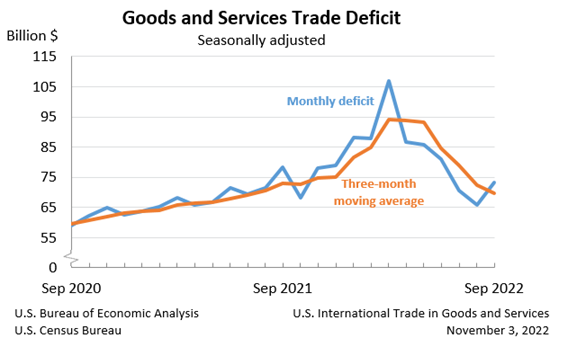Valorie Rice, Senior Business Information Specialist and
Shaw Zeider, EBRC Undergraduate Student Researcher
Current data releases as of 11 Nov 2022
Only two metropolitan areas in Arizona had more affordable housing than the nation in the third quarter 2022. Nationally, just 42.2% of new and existing homes sold in the third quarter were affordable to a family earning the U.S. median income. The National Association of Home Builders (NAHB)/Wells Fargo Housing Opportunity Index latest release on November 10 indicated that affordability had fallen to its lowest level in more than 10 years. Arizona metropolitan areas experienced the lowest affordability since the current series began (in 2012). The share of homes affordable to those earning the median family income for their areas in Arizona were: 50.1% in Sierra Vista, 45.7% in Lake Havasu City-Kingman, 40.2% in Tucson, 38.9% in Yuma, 28.0% in Prescott Valley-Prescott, 22.5% in Phoenix, and 20.5% in Flagstaff.
House prices have begun to taper off. Phoenix reported an annual house price gain of 17.1% in August compared to 22.3% for July. The U.S. National Home Price NSA Index August gain of 13.0% was down from 15.6% in July. This was the largest deceleration in the history of the index according to the S&P CoreLogic Case-Shiller October 25 release. The 20-city composite had a 13.1% year-over-year gain in August compared to 16.0% in July. Prices declined on a month-to-month basis in all 20 cities included in the index. Miami had the largest 12-month house price gain at 28.6% while San Francisco posted the lowest twelve-month increase of 5.6%.
The U.S. Consumer Price Index (CPI-U) had a monthly increase of 0.4% in October on a seasonally adjusted basis, the same as in September. Over half of the monthly increase was contributed by shelter prices. Energy also increased, with gasoline and electricity prices rising. The all items index less food and energy increased 0.3% over the month. The annual inflation rate for the U.S. was 7.7% in October. Prices in the Phoenix metropolitan area were up 12.1% over the year in October (released on even numbered months), which was the highest of all areas tracked.
Use your cursor as a tooltip to switch series ON/OFF at the bottom of the chart. Run your cursor over the chart to view values.
Arizona had 695 bankruptcy filings in October, 20 more than October of last year. This was the third month in a row that the number of bankruptcies surpassed the prior year, reversing a trend that began in January 2020 of decreased filings year over year. Year-to-date, bankruptcies were down 10.0% for the state, -9.8% for the Phoenix office, -6.7% for the Tucson office and -26.4% for the Yuma office. Year-to-date totals by chapter indicate that Chapter 7 (liquidation) was lower than the same period last year by 14.5%. Chapters 11 (reorganization) and 13 (individual debt) have exceeded last year by 14.3% and 17.9%, respectively. Navajo is the only county with more bankruptcy filings so far this year compared to last all other counties have experienced a decrease in bankruptcies. The Phoenix office includes Apache, Coconino, Gila, Maricopa, Navajo, and Yavapai counties. The Tucson office manages Cochise, Graham, Greenlee, Pima, Pinal, and Santa Cruz counties, while the Yuma office represents La Paz, Mohave, and Yuma counties.
Total nonfarm payroll employment in the U.S. increased by 261,000 in October, although the unemployment rate rose to 3.7% according to the November 4 Bureau of Labor Statistics release. Employment increases were driven primarily in health care, professional and technical services, and manufacturing. The unemployment rate increased by 0.2 percentage points over the month. Those with less than a high school diploma had the largest increase in unemployment moving up 0.7 percentage points to 6.3%. The labor force participation rate was 62.2% and the employment-population ratio was 60.0%, these values have changed very little since early 2022.
After 5 months of U.S. trade deficit decline, there was a sharp increase in September. The September trade deficit of $73.3 billion was an increase of $7.6 billion over the revised August figure of $65.7 billion. Exports were down $2.8 billion while imports were up $4.8 billion. Year-to-date, the goods and services deficit increased $125.6 billion from the same period in 2021. Exports increased by $378.1 billion or 20.2 percent. Imports increased $503.6 billion or 20.2 percent year-to-date according to the November 3 joint U.S. Census Bureau and U.S. Bureau of Economic Analysis release.
Real gross domestic product (GDP) increased at an annual rate of 2.6% in the third quarter according to an advanced estimate released Oct 27 from the U.S. Bureau of Economic Analysis. A second estimate based on more complete source data will be released at the end of November. Real GDP decreased 0.6% nationally in the second quarter of 2022.
State personal consumption expenditures (PCE) increased 12.7% nationally in 2021 after decreasing 1.9% in 2020. Arizona’s PCE was above the national average at 13.1%, driven by large increases in food services and accommodations and in health care. Changes in PCE ranged from 16.3% in Utah to 9.4% in New York for 2021 based on the October 6 Bureau of Economic Analysis release. The total per capita personal consumption expenditure in 2021 was $44,875 for Arizona and $47,915 nationally.






